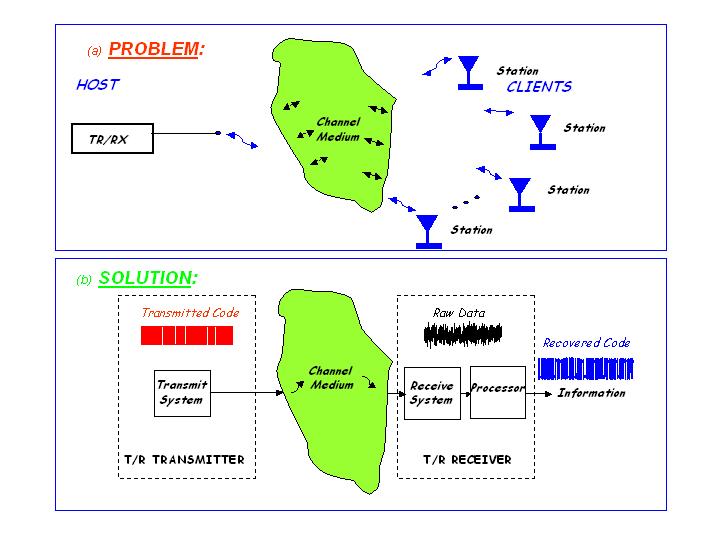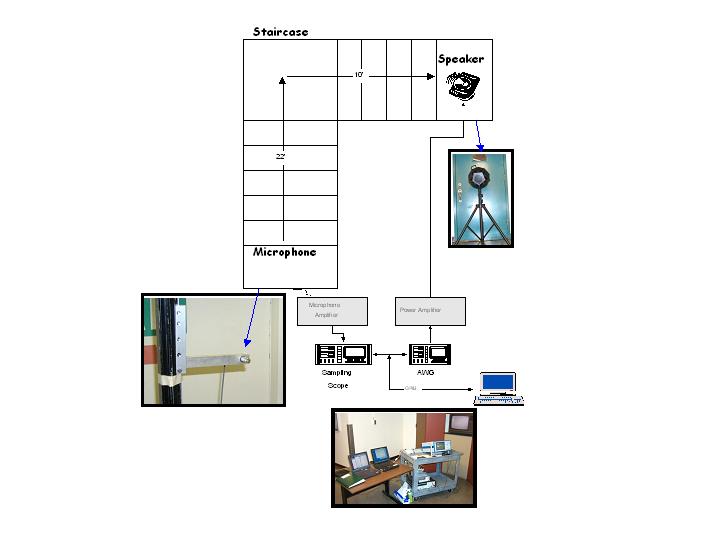James V. Candy - candy1@llnl.gov
University of California
Lawrence Livermore National Laboratory
P.O. Box 808, L-156
Livermore, CA 94551
Popular version of paper 2pSPa1
Presented Tuesday afternoon, November 11, 2003
146th Meeting of the Acoustical Society of America, Austin, Texas
Communicating in a complex environment is a daunting problem. Think of cellular communications in a hostile urban setting populated with a multitude of buildings and vehicles, the complexity of a large number of shouting brokers common at the stock exchange, or military operations in an environment with topographic features such as hills, valleys, mountains, etc. These inherent obstructions cause transmitted sounds or signals to bounce, bend and spread in a multitude of directions distorting both their shape and arrival times at receiver locations. Imagine being lost in a maze of caves that cause multiple echoes. You shout for help (shout for help) but at the entrance all that can be heard is garbled noise (garbled shout). This is the problem with transmitting information in a complex environment. Sound in the form of waves is susceptible to multiple paths created by a variety of possible obstructions. We can observe this phenomenon by dropping a pebble into a puddle and observing the rings (waves) propagate outwardly while being distorted by the presence of a large rock or twig. This is precisely the type of communications problem we are attempting to solve. We utilize the physics of acoustic wave propagation to mitigate the noxious effects created by the hostile medium. Using this in a constructive manner also enables a huge benefit in communications. We employ a technique called time-reversal (T/R) communications to accomplish this feat.
Time-reversal is a simple notion that we have all observed. For instance, consider watching a movie of the demolition of a building. Merely running the movie in-reverse or equivalently running it backwards in time allows us to reconstruct the building, at least visually; even though it cannot be reconstructed physically. Using this same idea, time-reversal can be applied to "reconstruct" communication signals by retracing all of the multiple paths from the source that originally distorted the transmitted signals in the first place! That is, if we broadcast a sound (such as the shout for help) into a hostile environment or medium, the sound waves bounce, bend and spread, yet eventually make their distorted way to the receiver. Unfortunately, they arrive at the receiver at various times and signal levels creating a completely jumbled message (garbled shout). In order to separate or decompose the individual components of the message, the T/R receiver must use its knowledge of the medium to not only separate each path, but also to add them together in some coherent manner to extract the message with little or no distortion and increase their signal levels (such as the original shout for help).
The basic communications problem is to transmit coded sound information through the hostile environment or medium and receive it at desired receiver or client stations. These client stations can also broadcast back through the medium to create a two-way conversation as shown in FIG. 1a. The proposed solution to this problem is shown in FIG. 1b where the transmitted code is distorted by the medium, received and then processed by the T/R receiver to extract it at the output with minimal distortion.

FIG. 1. Communications in a hostile environment: (a) The basic problem including
the host transmitter/receiver, hostile medium and client receiver stations.
(b) A T/R receiver solution showing the transmitter, medium and a particular
T/R receiver structure extracting the coded information from the distorted received
data.
In this paper we briefly describe the development of techniques to construct a variety of receivers, sometimes called "software radios" based on the theory of T/R communications. The particular T/R receiver designs developed (e.g. see FIG. 1b above) are applied to controlled experimental data gathered from a hostile environment created by a one story, L-shaped, stairwell with three landings consisting of many acoustic obstructions such as protruding pipes, corrugated ceilings, rough walls and entry/exit doors deflecting and distorting the propagated sound waves. The stairwell along with the experimental setup is shown in FIG. 2 where we see the speaker sound source, microphone receiver and computer system used to capture and digitize the data. The results of processing this data with the T/R system to recover transmitted information is accomplished by essentially retracing the sound waves from the speaker.

FIG. 2. Controlled experimental set-up for T/R receiver designs: sound source
(loud speaker), hostile medium (stairwell with obstructions) and the microphone
receiver with the T/R receiver implemented in software on the computer.
With this in mind we demonstrate the performance of a T/R receiver below in FIG. 3 where the upper traces show the T/R processed signal (dotted blue line) including the synchronized coded information sequence (solid cyan line) and the transmitted code (red line). The code is composed of symbols that have either a +0.75 or -0.75 amplitude. Zooming on the trace in the lower portion of FIG. 3, we see both the recovered code prior to quantization (dotted cyan line) and the quantized code which precisely overlays the true transmitted code (solid red line). There is no symbol error confirming that the T/R receiver has a flawless performance on this data. That is, the true symbol values depicted by the asterisks are recovered from the T/R receiver output as shown by the circles. If there were any errors, the recovered T/ R receiver symbol (circle) would not overlay the true symbol (asterisk). Thus, we conclude that the T/R receiver is capable of performing in a hostile environment.
We demonstrate these results through the attached audio files which first broadcasts,
the true symbol sound (as shown visually in FIG. 3 below) (listen
to the code) followed by the received microphone measurement after propagating
the code through the medium (microphone recording of code).
Note the abrupt sound of the code compared to its distorted (by the stairwell
medium) sound made up of echoes, spreading and noise. The next two sound files
are the true code again (code) followed by the quantized
or recovered code (recovered code) at the output of
the T/R receiver as shown visually in the lower portion of FIG. 3 below. Thus,
we can conclude that the T/R receiver system is capable of recovering transmitted
code information mitigating the distortions in a hostile environment.

FIG. 3. Time-reversal receiver output for the controlled stairwell experiment:
(a) Raw T/R receiver output (dotted blue line) with synchronized code (solid
cyan line) with true code (red line) superimposed (upper trace). (b) Zoomed
synchronized T/R output (dotted cyan line) with both quantized code information
extracted and true code superimposed (red line) along with estimated symbol
"O" and true symbol "*" overlaid demonstrating flawless
T/R receiver operation.